NASA is one of the few organizations in the world that makes headlines for releasing better versions of old photos. That doesn't work for most people when posting new photos of their trip to the Poconos or something.
But when it's the Pillars of Creation, it tends to be justified, even if the photos are only about a week apart. Recently the Webb telescope used its Near-Infrared Camera to release a sharper, more detailed image of the region with a view that peered through much of the space dust that normally obscures the area.
Like a photographer changing the setting on a camera, NASA then switched to the Mid-Infrared Instrument. This helps illuminate the dust that cloaks the scene, according to NASA.
"And while mid-infrared light specializes in detailing where dust is, the stars aren't bright enough at these wavelengths to appear. Instead, these looming, leaden-hued pillars of gas and dust gleam at their edges, hinting at the activity within," NASA states.
In this view, the hauntingly blue gas and dust take precedence, and the stars almost completely disappear from sight. It gives the appearance of some great ghostly hand that looks like it flicks stars into existence (or at least does really elaborate card tricks).
Which is sort of what's happening. Thousands of stars have formed within the pillars, using dust as a core recipe ingredient.
"Many stars are actively forming in these dense blue-gray pillars. When knots of gas and dust with sufficient mass form in these regions, they begin to collapse under their own gravitational attraction, slowly heat up -- and eventually form new stars," NASA writes.
Located roughly 6,500-7,000 light-years from Earth in the Eagle nebula, the Pillars of Creation photos have a long history of rereleases, like any other franchise. It first achieved fame when the Hubble Space Telescope observed it in 1995. Then the Heschel Space Observatory caught a peek in 2011, followed by another try by Hubble in 2014 with a newer camera.
With these last two new ones captured in quick succession by the Webb telescope, we may soon be entering double-digit numbers. But unlike other franchises, these appear to be only getting better.

